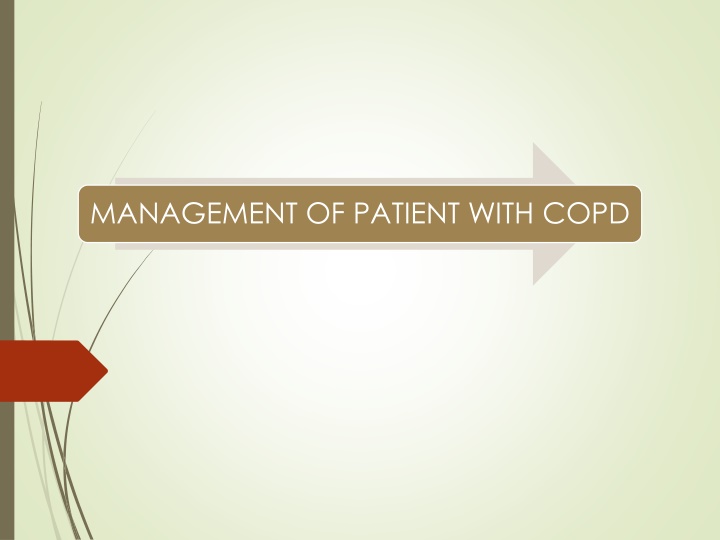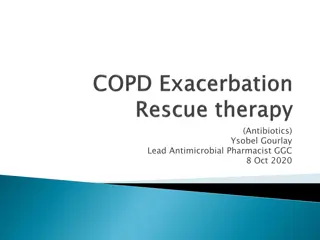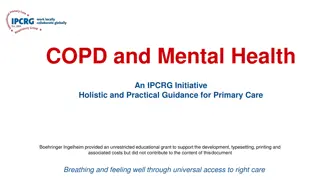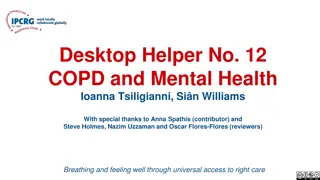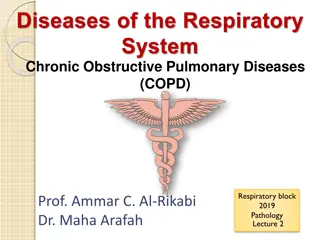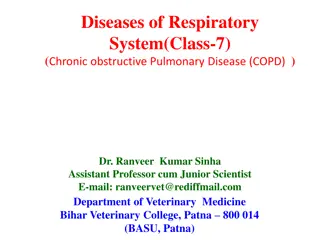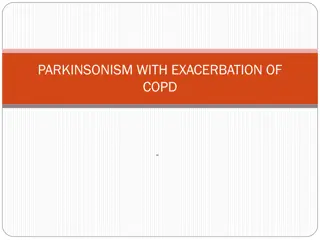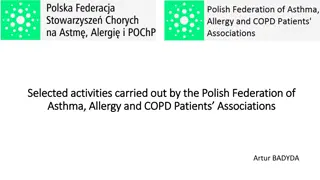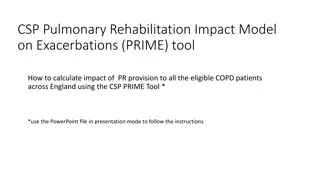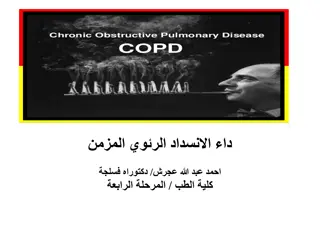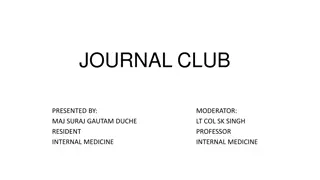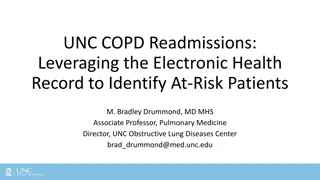Management of Patients with COPD
Chronic obstructive pulmonary disease (COPD) is characterized by airflow limitation that is not fully reversible. Understanding the pathophysiology, risk factors, and nursing interventions is crucial for patient care. This article explores the definition, pathophysiology, and key aspects of COPD management, including chronic bronchitis and asthma.
Download Presentation

Please find below an Image/Link to download the presentation.
The content on the website is provided AS IS for your information and personal use only. It may not be sold, licensed, or shared on other websites without obtaining consent from the author.If you encounter any issues during the download, it is possible that the publisher has removed the file from their server.
You are allowed to download the files provided on this website for personal or commercial use, subject to the condition that they are used lawfully. All files are the property of their respective owners.
The content on the website is provided AS IS for your information and personal use only. It may not be sold, licensed, or shared on other websites without obtaining consent from the author.
E N D
Presentation Transcript
LEARNINIG OBJECTIVES On completion of this chapter, the learner will be able to: 1. Describe the pathophysiology of chronic obstructive pulmonary disease (COPD). 2. Discuss the major risk factors for developing COPD and nursing interventions to minimize or prevent these risk factors. 3. Use the nursing process as a framework for care of the patient with COPD. 4. Develop a teaching plan for patients with COPD. 5. Describe the pathophysiology of asthma. 6. Discuss the medications used in asthma management. 7. Describe asthma self-management strategies. 8. Describe the pathophysiology of cystic fibrosis.
Definition of COPD Chronic obstructive pulmonary disease (COPD) is a disease state characterized by airflow limitation that is not fully reversible. COPD may include diseases that cause airflow obstruction (eg, emphysema, chronic bronchitis) or a combination of these disorders. Other diseases such as cystic fibrosis, bronchiectasis, and asthma were previously classified as types of chronic obstructive lung disease. However, asthma is now considered a separate disorder and is classified as an abnormal airway condition characterized primarily by reversible inflammation. COPD can coexist with asthma. Both of these diseases have the same major symptoms; however, symptoms are generally more variable in asthma than in COPD.
Pathophysiology of COPD In COPD, the airflow limitation is both progressive and associated with an abnormal inflammatory response of the lungs The inflammatory response occurs throughout the airways, parenchyma, and pulmonary vasculature. Because of the chronic inflammation and the body s attempts to repair it, narrowing occurs in the small peripheral airways. Over time, this injury-and-repair process causes scar tissue formation and narrowing of the airway lumen.
Pathophysiology Airflow obstruction may also be due to parenchymal destruction as seen with emphysema, a disease of the alveoli or gas exchange units. Early in the course of COPD, the inflammatory response causes pulmonary vasculature changes that are characterized by thickening of the vessel wall. These changes may occur as a result of exposure to cigarette smoke or use of tobacco products or as a result of the release of inflammatory mediators
copd http://www.animatedcopdpatient.com/ http://www.animatedcopdpatient.com/
Chronic Bronchitis Chronic bronchitis, a disease of the airways, is defined as the presence of cough and sputum production for at least 3 months in each of 2 consecutive years. In many cases, smoke or other environmental pollutants irritate the airways, resulting in hypersecretionof mucus and inflammation.
BRONCHITIS This constant irritation causes the mucus-secreting glands and goblet cells to increase in number, ciliary function is reduced, and more mucus is produced. The bronchial walls become thickened, the bronchial lumen is narrowed, and mucus may plug the airway
Emphysema Emphysema is a pathological term that describes an abnormal distention of the air spaces beyond the terminal bronchioles, with destruction of the walls of the alveoli. It is the end stage of a process that has progressed slowly for many years.
As the walls of the alveoli are destroyed (a process accelerated by recurrent infections), the alveolar surface area in direct contact with the pulmonary capillaries continually decreases, causing an increase in dead space (lung area where no gas exchange can occur) and impaired oxygen diffusion, which leads to hypoxemia.
Risk Factors for COPD Exposure to tobacco smoke accounts for an estimated 80% to 90% of COPD cases Passive smoking Occupational exposure Ambient air pollution Genetic abnormalities, including a deficiency of alpha1- antitrypsin, an enzyme inhibitor that normally counteracts the destruction of lung tissue by certain other enzymes
ASSESSMENT Key Factors to Assess in the COPD Patient s Health History Exposure to risk factors types, intensity, duration Past medical history respiratory diseases/problems, including asthma, allergy, sinusitis, nasal polyps, history of respiratory infections Family history of COPD or other chronic respiratory diseases Pattern of symptom development History of exacerbations or previous hospitalizations for respiratory problems Presence of comorbidities Appropriateness of current medical treatments Impact of the disease on quality of life Available social and family support for patient Potential for reducing risk factors (eg, smoking cessation)
Diagnostic findings Spirometry is used to evaluate airflow obstruction, which is determined by the ratio of FEV1 (volume of air that the patient can forcibly exhale in 1 second) to forced vital capacity (FVC). Obstructive lung disease is defined as a FEV1/FVC ratio of less than 70%. Arterial blood gas measurements may also be obtained to assess baseline oxygenation and gas exchange.
Diagnostic findings In addition, a chest x-ray may be obtained to exclude alternative diagnoses Lastly, alpha1 antitrypsin deficiency screening may be performed for patients under age 45 or for those with a strong family history of COPD.
COMPLICATIONS OF COPD Respiratory insufficiency and failure are major life-threatening complications of COPD. The acuity of the onset and the severity of respiratory failure depend on the patient s baseline pulmonary function, pulse oximetry or arterial blood gas values, comorbid conditions, and the severity of other complications of COPD.
Medical Management RISK REDUCTION PHARMACOLOGIC THERAPY Bronchodilators. Corticosteroids Other medication like flue vaccine
Oxygen therapy on COPD Oxygen therapy can be administered as long-term continuous therapy, during exercise, or to prevent acute dyspnea. Longterm oxygen therapy has been shown to improve the patient s quality of life and survival .For patients with an arterial oxygen pressure (PaO2) of 55 mm Hg or less on room air, maintaining a constant and adequate oxygen saturation (>90%) is associated with significantly reduced mortality and improved quality of life.
Indications for oxygen supplementation include PaO2 of 55 mm Hg or less or evidence of tissue hypoxia and organ damage such as cor pulmonale, secondary polycythemia, edema from right heart failure, or impaired mental status. In patients with exercise-induced hypoxemia, oxygen supplementation during exercise can improve performance. Patients who are hypoxemic while awake are likely to be so during sleep. Therefore, nighttime oxygen therapy is recommended as well, and the prescription for oxygen therapy is for continuous, 24- hour use. Intermittent oxygen therapy is indicated for those who desaturate only during exercise or sleep.
NURSING ALERT on o2 therapy for COPD Because hypoxemia stimulates respiration in the patient with severe COPD, increasing the oxygen flow to a high rate may greatly raise the patient s blood oxygen level. At the same time, this will suppress the respiratory drive, causing increased retention of carbon dioxide and CO2 narcosis. The nurse should closely monitor the patient s respiratory response to oxygen administration via physical assessment, pulse oximetry, and/or arterial blood gases.
Surgical intervention Bullectomy Lung Volume Reduction Surgery Lung transplantation
PULMONARY REHABILITATION The primary goal of rehabilitation: is to restore patients to the highest level of independent function possible and to improve their quality of life Most pulmonary rehabilitation programs include educational, psychosocial, behavioral, and physical components. Breathing exercises and retraining and exercise programs are used to improve functional status, and the patient is taught methods to alleviate symptoms.
Nursing management Patient education Breathing exercises Inspiratory muscle training Activity pacing Self-Care Activities Physical Conditioning Oxygen Therapy. Nutritional Therapy Coping Measures.
Nursing care of patient with COPD Assessment Assessment involves obtaining information about current symptoms as well as previous disease manifestations.
NURSING DIAGNOSIS Based on the assessment data, the patient s major nursing diagnoses may include the following: Impaired gas exchange and airway clearance due to chronic inhalation of toxins Impaired gas exchange related to ventilation perfusion inequality Ineffective airway clearance related to bronchoconstriction, increased mucus production, ineffective cough, bronchopulmonary infection, and other complications Ineffective breathing pattern related to shortness of breath, mucus, bronchoconstriction, and airway irritants Activity intolerance due to fatigue, ineffective breathing patterns, and hypoxemia Deficient knowledge of self-care strategies to be performed
Planning and Goals The major goals for the patient may include smoking cessation,improved gas exchange, airway clearance, improved breathing pattern, improved activity tolerance, maximal self- management,improved coping ability, adherence to the therapeutic program and home care, and absence of complications.
Nursing Interventions PROMOTING SMOKING CESSATION IMPROVING GAS EXCHANGE: the nurse must administer the medications (bronchodilators & corticosteroids) properly and be alert for potential side effects. ACHIEVING AIRWAY CLEARANCE : Diminishing the quantity and viscosity of sputum can clear the airway and improve pulmonary ventilation and gas exchange it can be achieved through :
All pulmonary irritants should be eliminated or reduced, particularly cigarette smoking, which is the most persistent source of pulmonary irritation. Breathing & coughing exercise Chest physiotherapy with postural drainage Increase fluid intake
IMPROVING BREATHING PATTERNS Training in diaphragmatic breathing reduces the respiratory rate, increases alveolar ventilation, and sometimes helps expel as much air as possible during expiration. Pursed-lip breathing helps to slow expiration, prevents collapse of small airways, and helps the patient to control the rate and depth of respiration. It also promotes relaxation, which enables the patient to gain control of dyspnea and reduce feelings of panic
IMPROVING ACTIVITY TOLERANCE Education is focused on rehabilitative therapies to promote independence in executing activities of daily living These may include pacing activities throughout the day or using supportive devices to decrease energy expenditure. The nurse evaluates the patient s activity tolerance and limitations and
ENHANCING SELF-CARE STRATEGIES Setting Realistic Goals Avoid extreme temperature : The nurse instructs the patient to avoid extremes of heat and cold. Heat increases the body temperature, thereby raising oxygen requirements; cold tends to promote bronchospasm. Air pollutants such as fumes, smoke, dust, and even talcum, lint, and aerosol sprays may initiate bronchospasm. High altitudes aggravate hypoxemia.
Modifying Lifestyle Patients with COPD should adopt a lifestyle of moderate activity,ideally in a climate with minimal shifts in temperature and humidity. As much as possible, the patient should avoid emotional disturbances and stressful situations that might trigger a coughing episode. Smoking cessation is the single most important therapeutic intervention for patients with COPD. There are many strategies, including prevention, cessation with or without oral or topical patch medications, and behavior modification techniques.
MONITORING AND MANAGING POTENTIAL COMPLICATIONS: The nurse caring for the patient with COPD must assess for various complications, such as life- threatening respiratory insufficiency and failure and respiratory infection and atelectasis, which may increase the patient s risk for respiratory failure.
